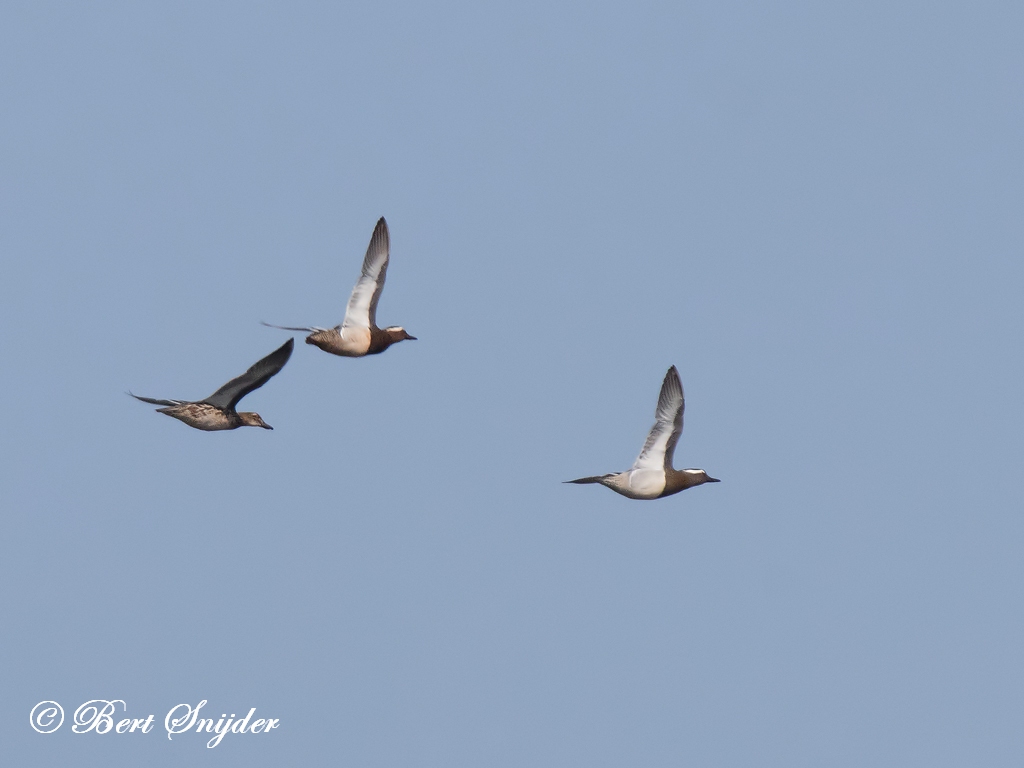Garganey, Zomertaling, Knäkente, Marreco, Cerceta Carretona
Spotted in the Alentejo region of Portugal. Garganey sound
The Garganey (Anas querquedula) is a small dabbling duck. It breeds in much of Europe and western Asia, but is strictly migratory, with the entire population moving to southern Africa, India (in particular Santragachi), and Australasia in winter, where large flocks can occur. This species was first described by Linnaeus in 1758 under its current scientific name. Like other small ducks such as the Common Teal, this species rises easily from the water with a fast twisting wader-like flight.

More photos at the bottom of this page:
Their breeding habitat is grassland adjacent to shallow marshes and steppe lakes.
The adult male is unmistakable, with its brown head and breast with a broad white crescent over the eye. The rest of the plumage is grey, with loose grey scapular feathers It has a grey bill and legs. In flight it shows a pale blue speculum with a white border. When swimming it will show prominent white edges on its tertials. His crown (anatomy) is dark and face is reddish-brown.
Some care is needed in separating the brown female from the similar Common Teal, but the stronger face markings and more frequent head-shaking when dabbling are good indicators. Confusion with the female of the Blue-winged Teal is also possible, but the head and bill shape is different, and the latter species has yellow legs. Pale eyebrow, dark eye line, pale lore spot bordered by a second dark line.
These birds feed mainly by skimming rather than upending.
The male has a distinctive crackling mating call; the female is rather silent for a female duck, but can manage a feeble quack.
Garganey are rare breeding birds in the British Isles, with most breeding in quiet marshes in Norfolk and Suffolk. In Ireland a few pairs now breed in Wexford, with occasional breeding elsewhere.
The Garganey is one of the species to which the Agreement on the Conservation of African-Eurasian Migratory Waterbirds (AEWA) applies. The status of the Garganey on the IUCN Red List is Least Concern.









Other synonyms:
Afrikaans: Somereend
Asturian: Coríu, Zarceta Ronquiella
Breton: Ar c’hrak-hañv
Catalan: Cetla blanca, Roncadell, Xarrasclet
Catalan (Balears): Cetla blanca
Valencian: Roncadell
Czech: Círka modrá, èírka modrá
Welsh: Hwyaden addfain
Danish: Atlingand
German: Knaekente, Knäkente
Maldivian: Kunburu Reyru
English: Crackling Teal, Cricket Teal, European Mallard, Garganey, Garganey Teal, Summer Teal
Spanish: Cerceta Carretona, Cerceta Ceja Blanca, cerceta cejablanca, Cerceta Cejiblanca
Spanish (Mexico): cerceta ceja blanca, cerceta cejablanca, Cerceta Cejiblanca
Estonian: Rägapart
Basque: Udako zertzeta, Uda-zertzeta, Xarrasclet
Finnish: Heinätavi
Faroese: Krypilsont, Krypils-ont, Teymont
French: Sarcelle d’été
Frisian: Skiertsjilling
Irish: Praslacha Shamhraidh
Gaelic: Lach Crann
Galician: Cerceta albela, Xarrasclet
Manx: Thunnag houree
Croatian: Patka Pupcanica
Hungarian: Böjti réce
Indonesian: Itik Jurai
Icelandic: Taumönd
Italian: Canaròl, Marzaiola, Marzaiola eurasiatica
Modenese: Canaròl
Japanese: Aji, shimaaji, Shima-aji
Cornish: Hos haf
Latin: Anas querquedula, Querquedula querquedula
Malay: Itik Garganey
Maltese: Sarsella îamra
Dutch: Zomertaling
Norwegian: Knekkand
Polish: cyranka, cyranka (zwyczajna), Cyranka zwyczajna
Portuguese: Marreco, Marreco-europeu
Romansh: Anda da mars
Russian: Chirok-treskunok
Scots: Lach crann
Northern Sami: Doadjosuorsa
Slovenian: regeljc, reglja
Albanian: Marsatorja
Serbian: Krdža, patka pupcanica
Swedish: Årta
Swahili: Bata Mchirizi-mweupe
Birdwatching Holiday Alentejo, Birding Portugal for birders. Guided Birdwatching Tours and Trips.